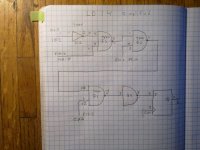Marty
Veteran Member
Hi All;
More differences between the lists..
On the INT sorted List A33 (E11) (page 34) pin 13 goes to A8-3 (G9-3) and A21-1 (E15-1) is crossed off..
On the EXT sorted List E11 (A33) (page 13) pin 13 goes to G9-3 (A8-3) and E15-1 (A21-1)..
On the INT sorted List A36 (G16) (Page 37) pin 3 goes to A43-10 (K2-10) and is crossed off and A13-5 (M15-5) is written in..
This is part of the Mod I referred to in the last posting.. A simplification of the circuit.. I have not implemented it..
On the EXT sorted List G16 (A36) (page 50) goes to K2-10 (A43-10)..
On the INT sorted List A37 (E4) (page 38) Pin 4 has it going to B19-1 (F12-1) which is crossed out and it is wired to A37-5..
Signal A0 is eliminated.. I have the pin Floating..
On the EXT sorted List E4 (A37) (Page 6) is going to F12-1 (B19-1)..
On the INT sorted List A43 (K2) (page 42) pin 8 goes to A36-4 (G16-4) and it is crossed out..
On the INT sorted List A43 (K2) (page 42) pin 9 goes to A11-2 (K4-2) and it is crossed out..
On the INT sorted List A43 (K2) (page 42) pin 10 goes to A36-3 (G16-3) and it is crossed out..
On the EXT sorted List K2 (A43) (page 72) pin 8 goes to G16-4 (A36-4)..
On the EXT sorted List K2 (A43) (page 72) pin 9 goes to K4-2 (A11-2)..
On the EXT sorted List K2 (A43) (page 72) pin 10 goes to G16-3 (A36-3)..
This finishes the Mod referred to on last posting.. I have not implemented it..
On the INT sorted List A45 (M10) (Page 44) pin 3 goes to A9-10 (M1-10) and A45-6 (M10-6) has been added..
On the INT sorted List A45 (M10) (Page 44) pin 6 goes to B47-3 (L8-3) and A10-1 (M16-1) have both been crossed out and A45-3 has been added..
A0 is eliminated and I have left M10-6 floating..
On the EXT sorted List M10 (A45) (page 106) pin 3 goes to M1-10 (A9-10)..
On the EXT sorted List M10 (A45) (page 106) pin 6 goes to L8-3 (B47-3) and M16-1 (A10-1)..
On the INT sorted List A49 (G4) (page 48) pin 2 goes to B24-12 (F2-12) and B35-4 (H8-4) Both have been crossed out and attached to P2-55 (MB4)..
On the EXT sorted List G4 (A49) (page 38) pin 2 goes to F2-12 (B24-12) and H8-4 (B35-4) (PC4)..
On this and the following Signals involving PC00 thru PC04, I have tried it using MB00 thru MB04 and it doesn't WORK !! So, I have Left all of these attached to PC00 thru PC04..
THANK YOU Marty
More differences between the lists..
On the INT sorted List A33 (E11) (page 34) pin 13 goes to A8-3 (G9-3) and A21-1 (E15-1) is crossed off..
On the EXT sorted List E11 (A33) (page 13) pin 13 goes to G9-3 (A8-3) and E15-1 (A21-1)..
On the INT sorted List A36 (G16) (Page 37) pin 3 goes to A43-10 (K2-10) and is crossed off and A13-5 (M15-5) is written in..
This is part of the Mod I referred to in the last posting.. A simplification of the circuit.. I have not implemented it..
On the EXT sorted List G16 (A36) (page 50) goes to K2-10 (A43-10)..
On the INT sorted List A37 (E4) (page 38) Pin 4 has it going to B19-1 (F12-1) which is crossed out and it is wired to A37-5..
Signal A0 is eliminated.. I have the pin Floating..
On the EXT sorted List E4 (A37) (Page 6) is going to F12-1 (B19-1)..
On the INT sorted List A43 (K2) (page 42) pin 8 goes to A36-4 (G16-4) and it is crossed out..
On the INT sorted List A43 (K2) (page 42) pin 9 goes to A11-2 (K4-2) and it is crossed out..
On the INT sorted List A43 (K2) (page 42) pin 10 goes to A36-3 (G16-3) and it is crossed out..
On the EXT sorted List K2 (A43) (page 72) pin 8 goes to G16-4 (A36-4)..
On the EXT sorted List K2 (A43) (page 72) pin 9 goes to K4-2 (A11-2)..
On the EXT sorted List K2 (A43) (page 72) pin 10 goes to G16-3 (A36-3)..
This finishes the Mod referred to on last posting.. I have not implemented it..
On the INT sorted List A45 (M10) (Page 44) pin 3 goes to A9-10 (M1-10) and A45-6 (M10-6) has been added..
On the INT sorted List A45 (M10) (Page 44) pin 6 goes to B47-3 (L8-3) and A10-1 (M16-1) have both been crossed out and A45-3 has been added..
A0 is eliminated and I have left M10-6 floating..
On the EXT sorted List M10 (A45) (page 106) pin 3 goes to M1-10 (A9-10)..
On the EXT sorted List M10 (A45) (page 106) pin 6 goes to L8-3 (B47-3) and M16-1 (A10-1)..
On the INT sorted List A49 (G4) (page 48) pin 2 goes to B24-12 (F2-12) and B35-4 (H8-4) Both have been crossed out and attached to P2-55 (MB4)..
On the EXT sorted List G4 (A49) (page 38) pin 2 goes to F2-12 (B24-12) and H8-4 (B35-4) (PC4)..
On this and the following Signals involving PC00 thru PC04, I have tried it using MB00 thru MB04 and it doesn't WORK !! So, I have Left all of these attached to PC00 thru PC04..
THANK YOU Marty
Last edited:

